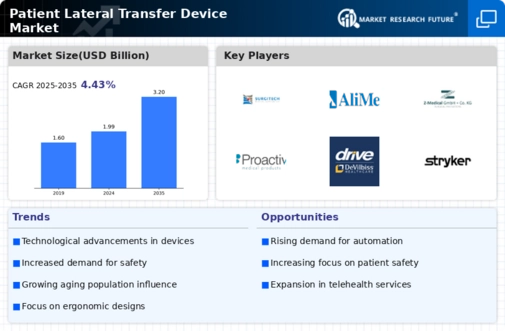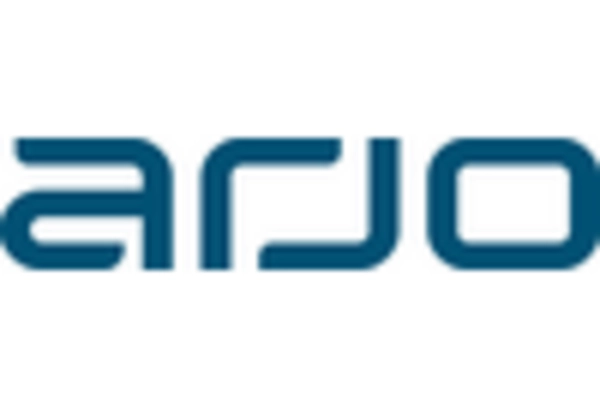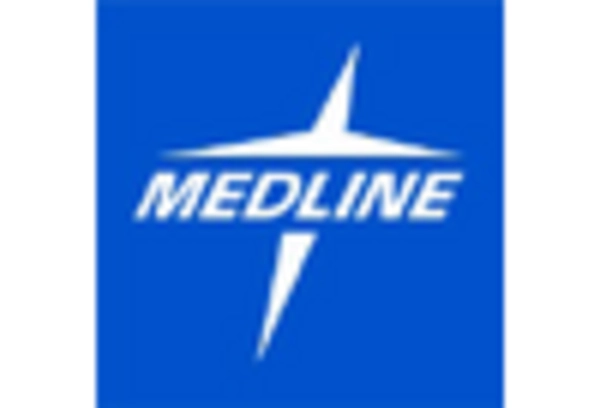Increasing Demand for Patient Safety
The Patient Lateral Transfer Device Market is experiencing a notable surge in demand driven by an increasing emphasis on patient safety. Healthcare facilities are prioritizing the reduction of patient handling injuries, which has led to a growing adoption of lateral transfer devices. According to recent data, approximately 50% of healthcare workers report experiencing musculoskeletal injuries due to manual patient handling. This statistic underscores the necessity for effective transfer solutions. As hospitals and care facilities strive to enhance safety protocols, the integration of advanced lateral transfer devices becomes essential. The market is projected to grow at a compound annual growth rate of 7% over the next five years, reflecting the urgent need for solutions that mitigate risks associated with patient transfers.
Regulatory Support and Funding Initiatives
The Patient Lateral Transfer Device Market benefits from regulatory support and funding initiatives aimed at improving healthcare safety standards. Governments and health organizations are increasingly recognizing the importance of safe patient handling practices, leading to the establishment of guidelines and funding programs to promote the adoption of lateral transfer devices. For example, certain regions have implemented financial incentives for healthcare facilities that invest in ergonomic equipment. This regulatory backing not only encourages the adoption of safer transfer methods but also fosters innovation within the industry. As a result, the market is likely to experience sustained growth, with an increasing number of facilities seeking compliance with safety regulations.
Aging Population and Rising Healthcare Needs
The Patient Lateral Transfer Device Market is significantly influenced by the aging population, which is leading to increased healthcare needs. As the demographic landscape shifts, a larger segment of the population requires medical attention, often necessitating assistance with mobility. This trend is particularly evident in regions where the elderly population is projected to double by 2050. Consequently, healthcare providers are compelled to invest in efficient transfer solutions to accommodate the growing number of patients requiring assistance. The market is expected to expand as facilities seek to enhance their operational efficiency while ensuring patient comfort and safety. This demographic shift is likely to drive innovations in lateral transfer devices, making them more adaptable to various patient needs.
Rising Awareness of Ergonomics in Healthcare
The Patient Lateral Transfer Device Market is also being propelled by a rising awareness of ergonomics in healthcare settings. As healthcare providers become more cognizant of the physical demands placed on staff during patient transfers, there is a growing recognition of the need for ergonomic solutions. This awareness is leading to a shift in purchasing decisions, with facilities prioritizing devices that minimize strain on healthcare workers. Research indicates that ergonomic interventions can reduce injury rates by up to 30%, making a compelling case for the adoption of lateral transfer devices. Consequently, the market is expected to grow as more organizations seek to implement ergonomic practices that enhance both staff well-being and patient care.
Technological Innovations in Medical Equipment
The Patient Lateral Transfer Device Market is witnessing a wave of technological innovations that are reshaping the landscape of patient handling. Advancements in materials and design have led to the development of lightweight, durable, and user-friendly transfer devices. For instance, the introduction of devices equipped with smart technology allows for real-time monitoring of patient movements, enhancing safety and efficiency. The market is projected to reach a valuation of USD 1 billion by 2026, driven by these innovations. As healthcare facilities increasingly adopt these advanced solutions, the demand for traditional manual handling methods is likely to decline, further propelling the growth of the lateral transfer device market.


















Leave a Comment